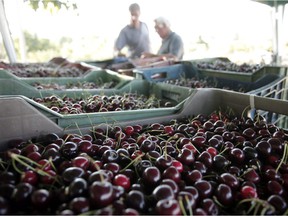In some cases, helicopters are being used to push warm air over the cherry trees.

Article content
KELOWNA — Some cherry farmers in BC are using helicopters to push warm air over their trees as unseasonably cool temperatures threaten this year’s cherry crop even before the fruit has formed.
Advertisement 2
Article content
Sukhpaul Bal, president of the BC Cherry Growers Association, said helicopters create an airflow rather than letting cool air sit over orchards, potentially damaging buds waiting to blossom.
“We’re getting into spring. Buds are starting to open up and blossoms are not too far down the road,” he said. “So, around this time of year, we don’t like to see too much cold weather.”
Environment Canada meteorologist Dave Wray attributed the below-seasonal temperatures to a cold air mass that has settled over the province.
Temperatures have been about seven degrees below normal over the past week, he said.
“There were quite a number of temperature records broken across the province.”
Bal said he is grateful that the cherry orchards haven’t had snow like in some parts of the United States.
advertisement 3
Article content
Cherry farmers and other fruit growers have endured much recently, as swinging weather patterns in the province led to fires, floods and last year’s so-called heat dome where the temperatures neared 50 C in some parts of BC, he said.
“The extreme shifts in the climate are challenging to farms.”
Added to the burden for the farming community is the labor shortage, Bal said.
The Canadian Federation of Agriculture has said the industry had a chronic labor shortage even before the arrival of COVID-19.
Mary Robinson, president of the Canadian Federation of Agriculture, said earlier this year that the physical nature of work in farms and the rural and isolated locations are some of the reasons for the labor shortage.
advertisement 4
Article content
COVID-19 caused agriculture producers to lose about $2.9 billion in 2020 because of the inability to find workers, said Robinson.
Bal said he’s hoping the weather returns to more seasonal temperatures before the buds bloom.
Some of the fruit begins to ripen in the first or second week of June, with several other varieties ready for harvest in August, he said.
It’s a bit early to tell if the cold has damaged the crop, I added.
“Overall, we’re still optimistic considering what could have happened. We’re still looking for a strong crop this year.”
Wray said temperatures should climb toward more seasonal temperatures by the weekend.
“April’s an interesting month,” he said. “Historically, it can be quite chilly. Other years, it’ll be nice and warm, like last year. So, this happens to be one of those cooler years.”
